Sportsmanship at its finest.
— Davis Cup (@DavisCup) November 25, 2018
The French team congratulate the Croatians after the #DavisCupFinal 👏👏👏#DavisCup #IdemoHrvatska #TousEnBleu pic.twitter.com/smtEi35y1Z
The 10 Biggest Off-Court Stories of 2018
By Kamakshi Tandon Dec 17, 2018Madrid, Spain
Joao Fonseca wins Masters 1000 debut in Madrid over fellow teen Alex Michelsen
By TENNIS.com Apr 25, 2024Style Points
Adrian Mannarino has a clothing sponsor! Lefty to debut with Celio at Mutua Madrid Open
By Baseline Staff Apr 25, 2024Roland Garros
FFT to reveal second retractable roof court at Roland Garros ahead of Paris Olympics
By Associated Press Apr 25, 2024Madrid, Spain
Rafael Nadal wins in Madrid homecoming, defeats 16-year-old American Darwin Blanch
By David Kane Apr 25, 2024Madrid, Spain
Dominant Coco Gauff double bagels Arantxa Rus in Madrid opener
By David Kane Apr 25, 2024Madrid, Spain
Maria Sakkari shakes off BJK Cup fatigue, brings clear mind to Madrid clay
By David Kane Apr 25, 2024Madrid, Spain
Naomi Osaka loses in Madrid, bows out to Liudmila Samsonova on clay
By David Kane Apr 25, 2024Your Game
Geared Up: Rafael Nadal plays out his illustrious career with Babolat and Nike
By Baseline Staff Apr 25, 2024Madrid, Spain
China's Wang Xinyu saves 10 match points in first-round Madrid win over Viktoriya Tomova
By TENNIS.com Apr 24, 2024The 10 Biggest Off-Court Stories of 2018
Published Dec 17, 2018
Advertising
Following years of complaints that the traditional form of Davis Cup was too time-consuming, complicated and hard to follow for the modern game, men's tennis now has three streamlined, compact team competitions instead: a revamped Davis Cup, a renewed ATP Cup, and the recently started Laver Cup.
But together, they will take up even more weeks in the schedule and create even more confusion when these very similar events are played within weeks of each other.
No wonder there is talk—both humorous and serious—of creating a 'Cup Cup' by combining some or all of these competing competitions.
A highly contentious vote at the ITF's annual general meeting approved sweeping changes to the Davis Cup, turning it into a one-week, 18-nation competition with the compromise of an initial round of home-and-away qualification ties. The decision was driven by the more than $120 million annually offered by the investment group Kosmos, backed by soccer star Gerard Pique, for rights to the historic team competition.
The ATP, undeterred, has announced its own team competition to be played at the beginning of the 2020 season, a little more than five weeks following the first edition of the revamped Davis Cup. It will be played across 10 days and involve 24 nations in three Australian cities, reflecting that Tennis Australia is partnering with the tour to hold the event.
The Laver Cup, which was started in 2017 by the Roger Federer-owned Team8 agency in partnership with Tennis Australia and now the USTA, is a three-day Europe vs. rest-of-the-world competition played two weeks after the US Open. But the ITF has indicated it is interested in moving Davis Cup to the same week as the Laver Cup, which fits better with player schedules. Laver Cup organizers want to keep their spot.
So for now, not much is settled except that players will be getting a lot more to play for their country—the Davis Cup will be offering $20 million in prize money, the ATP Cup $15 million and the Laver Cup millions in appearance fees, along with $1.5 million to the winning team.
This restless state of affairs was neatly captured by the ITF president, Dave Haggerty, getting booed by the crowds during the Davis Cup final between France and Croatia. But there was also a fitting finish to the traditional Davis Cup, as two of its most committed teams played each other in the final and then shared a hug in the locker rooms. The touching gesture captured much of what national team competition has meant to the sport, amid the uncertainly of what it will from now on.
2. Serena in the spotlight
Advertising
Reaching two Grand Slam finals since returning to tour from the birth of her first child, Serena Williams' comeback hasn't exactly been shabby. But she had an even bigger impact beyond the court, reflecting a celebrity status that is now independent of the sport.
It began even before she played her first event back. Williams withdrew from the Australian Open and revealed an interview with Vogue magazine that she had experienced significant complications following childbirth, sparking a wider social conversation about African-American maternal health. Williams embraced this position, citing social issues during public statements and appearing in charity campaigns.
While numerous players have recently returned to tour following pregnancy, it was Williams' comeback that prompted criticism of the WTA's ranking protections for such players. They are given a special ranking upon return, but it cannot be used for seeding. Williams was still given a special seeding by Wimbledon, though organizers did not specify why, followed by the US Open's announcement that it would take Williams's pregnancy leave into account in its own seedings.
The WTA has also revised its policy, allowing players returning from pregnancy extra protections, such as having to play seeds in the opening rounds and a longer period to use their special rankings—changes likely to have been most influenced by Williams.
Williams' recognizability was further underlined in being one of the most prominent guests at what was perhaps the biggest society event of the year, the royal wedding between Britain's Prince Harry and American actress Meghan Markle. Williams's daughter, Alexis, became a star in her own right, getting familiar with the tour as she traveled with her mom.
The catsuit Williams wore for the French Open grabbed attention during the event but even more when tournament organizers said they planned to ban it. The story became a hot topic when the comments were published just before the US Open, especially because the suit had been designed to provide compression following Williams's health problems. The furore also heightened notice of the designer 'tutu' dress she wore at Flushing Meadows.
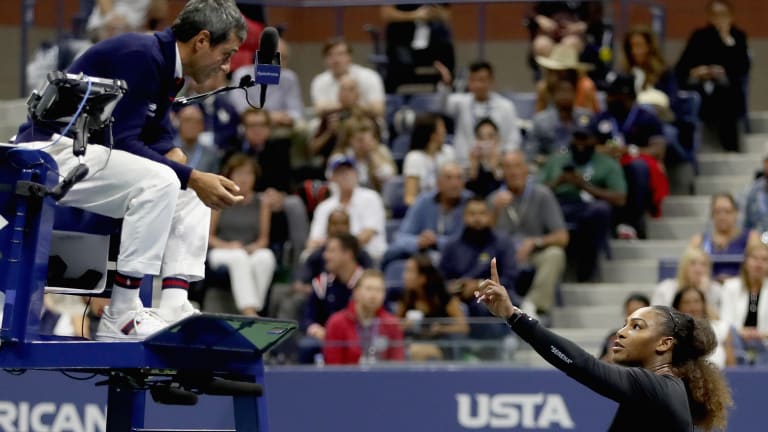
The 10 Biggest Off-Court Stories of 2018
© 2018 Getty Images
Advertising
But controversy also trailed Williams during the season. At Indian Wells, she was asked—by this journalist—about the Therapeutic Use Exemptions (TUEs) she had received to take an otherwise banned substance during the 2015 French Open, which was among several similar exemptions she had received airing that period. Williams said she had been sick during the event, and adamantly insisted she would not cheat as she wanted to be a role model for her daughter. Following a first-round defeat at Miami, Williams walked off court and left the tournament, not giving the required press conference.
A scheduled fourth-round clash with Maria Sharapova at the French Open reignited their simmering feud, this time around Sharapova's claim that Williams had cried following the Russian's victory at Wimbledon, and subsequently used an expletive to describe Sharapova. Williams slammed what she called a second-hand account, and then withdrew from the highly-anticipated meeting with an injury.
Another anti-doping issue came up just before Wimbledon, when WTA CEO Steve Simon was heard in a cell phone conversation saying that Williams had called him to complain about the amount of drug testing she was receiving, including an incident when a tester had come to her home unscheduled and initially refused to leave. Williams confirmed this, including that she had not returned to provide a sample because she was hours away at the time. She called the frequency of testing "discrimination," though anti-doping officials said she was being tested more frequently at her home because she was playing few events and not being tested as frequently during tournaments.
These two currents of celebrity and controversy came together in a wave at the US Open, where Williams was given three code violations during the final and accused the umpire of sexism. Williams was, correctly, given a warning for coaching when her coach, Patrick Mouratoglou, sent her a signal during the second set, and the 23-time Grand Slam champion demanded an apology from umpire Carlos Ramos for what she perceived as an implicit accusation of cheating.
Williams, who may have been under the impression that the warning had been withdrawn, then cracked a racquet, getting a point penalty for the second offence.
"Unbelievable, every time I play here I have problems," she said, likely referring to a spate of poor linecalling in 2004 and angry confrontations with officials during finals in 2009 and 2011. "I did not get coaching, I don't cheat. You need to make an announcement. I have a daughter and I stand for what's right for her."
The next change of sides saw Williams give another long speech to the umpire, during which she called him a "liar" and a "thief" while again demanding an apology for insinuating she was cheating. That got her a game penalty for a third offence, prompting Williams to protest to the tournament referee and supervisor that there were a lot of men "who have said a lot of things" and she had been penalized "because I am a woman, and that’s not right."
The episode, which had unfolded in national prime time and on screens around the world, set off a firestorm of public and media comment that went on for weeks. Both Williams and the umpire were defended and criticized in turn, though broadly speaking, tennis followers tended to side with the umpire, while casual watchers were more inclined to agree with Williams's wider social perspective.
It might have been good or bad, but it was definitely publicity. Williams was mentioned among those considered for Time's Person of the Year, and placed seventh among the most mentioned athletes on Twitter.

The 10 Biggest Off-Court Stories of 2018
© AFP/Getty Images
Advertising
The intricacy and intrigue of court scheduling usually stays inside the referee's office, but it was flung into the open this season perhaps like never before.
Two days of scorching heat during the first week of the Australian Open meant a huge difference between day and night conditions, accompanied by more scrutiny of who played when. The most ballyhooed was Thursday's decision to schedule Novak Djokovic and Gael Monfils during the day while Roger Federer played Jan-Lennard Struff at night. It was slightly surprising given that Djokovic-Monfils was the more attractive matchup, even though Federer was otherwise a night session regular as the biggest name in the tournament.
But there was a twist. While Federer had said he planned to request a night match, ESPN commentator Chris Fowler revealed that Djokovic's then-coach Andre Agassi had said Djokovic wanted the day session. That seemed puzzling since Djokovic has frequently had problems in the heat during his career, but during a four-set win it became apparent that he was a lot fitter than Monfils.
Djokovic, for his part, said he did not put in a specific request. "No, I think it was just, you know, whatever they put me," he said, but that would likely have been interpreted as having no preference.
Still, players endured 40 C (104 F) that day, with no roof used because the tournament's heat index—which uses temperature and humidity—was still 31.7, below the 32.5 required for the heat policy to come into effect. The following day was even hotter, but with less humidity, so play was again not stopped. Several players, including Djokovic and Monfils, complained that conditions were too hot.
Interestingly, all four men's and women's finalists—Federer, Marin Cilic, Caroline Wozniacki and Simona Halep—played at night during those two sweltering days. But Halep, who had thrilled the crowds but not done herself any favors by playing two marathon three-setters during the tournament, then played another three-setter in the heat and had to be hospitalized following the final.
The roof was shut for the men's final the next day because, as officials noted, it was the first time all tournament that the heat index was above 32.5, even when the final was played in the evening.
Statement on roof closure. pic.twitter.com/BBwNx6b8Lc
— #AusOpen (@AustralianOpen) January 28, 2018
Advertising
Tennis Channel Live: Reaction to the new ATP Cup
It was generally perceived that the indoor conditions would favor Federer, and unlike Cilic, he had chosen to warm up indoors even before the announcement from officials that the roof would be shut. Cilic appeared to take a set to get used to the indoor conditions, with Federer winning in five sets. The Croat would complain about the decision to play indoors for the first time all tournament.
But if Federer got some scheduling breaks at Melbourne, he would get no such thing at his next two majors. At Wimbledon, it would be Djokovic making a request to play his quarterfinal on Centre Court, sending Federer to No. 1 Court, on which he had not played in years.
Djokovic's insistence was likely based on the valid concern that he would otherwise have less playing time on Centre Court than his opponents in the final rounds. But it left Federer venturing onto No. 1 Court 1 against a tough quarterfinal opponent in Kevin Anderson, who was also more familiar with the stadium. Though Federer would have match points in the third set, Anderson came back to win in five sets and Federer would subsequently reveal that a hand injury had affected him during the tournament.
At a blisteringly hot US Open, Federer would play his fourth round match in the night session—as usual—but with 82 percent humidity and poor air flow in Arthur Ashe stadium. Federer had problems with the demanding conditions and was quite ill following his four-set defeat, according to ESPN commentator and the wife of Federer's agent, Mary Joe Fernandez. Meanwhile, his little-known opponent John Millman was from notoriously-humid Brisbane, as Federer noted, and coped much better that evening.
The following night, the doors were left open in Ashe to improve airflow in the stadium. Even before, the tournament had introduced a new heat break for the men because of the conditions, though there was also confusion and criticism around the impromptu change.
But rain rather than heat was the problem for much of the hardcourt season. At Cincinnati, Federer had to do double duty, playing his quarterfinal and semifinal on the same day. Heavy rain during Montreal also backed up Halep, who had to come back from a third-round win at night to play a quarterfinal the next day. A furious Halep accused the WTA of unfairness, saying they "always try to put me down in the schedule," though she did eventually win the tournament.
And the schedule got so clogged in Washington, D.C. that Andy Murray finished a match at 3 a.m. and quit the tournament rather than play again the next day, even though further rain meant he would not have had to take the court.
Advertising
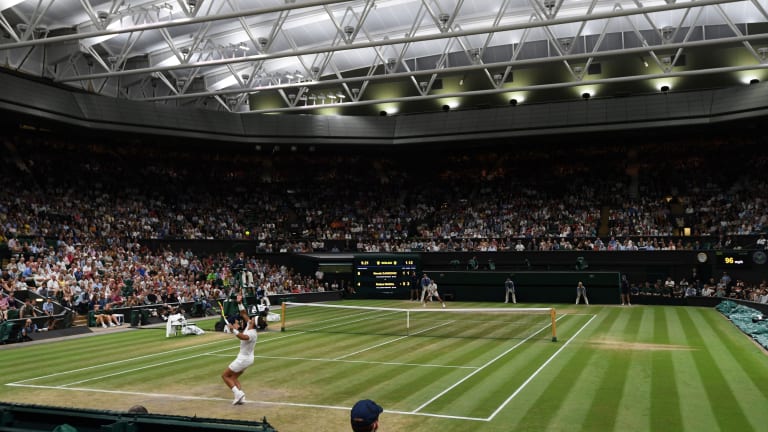
The 10 Biggest Off-Court Stories of 2018
© AFP/Getty Images
Advertising
With our Top 10 Matches of 2018 countdown complete, it's time to move on to the biggest stories of the past year, on and off the court. Yesterday, we ran down the most significant on-court happenings. Today, we look back at the top off-court headlines.
1. Cup fever
Back at Wimbledon, there was the season's other big roof controversy—the decision to play the Rafael Nadal-Djokovic semifinal indoors. The match started under the roof because the light was fading by the time the six-hour semifinal before it had finished. The tournament's unusual 11 p.m. curfew meant the match was then stopped in the fourth set, and resumed under the roof the next day despite bright sunlight.
If both players had agreed, the roof could have been opened for the second day of play. Nadal wanted it open, in what would have been better conditions for him. But Djokovic, who benefited from playing indoors, did not. Djokovic won in a tight fifth set. Though it was logical for the Serb to choose his preference, he seemed reluctant to acknowledge it.
"They told us we had to play under the roof," he said, but then added, "I was for the roof because we started to play, and I wanted to play in the same conditions."
Tournament officials told the New York Times that the decision had been based not on a rule but a protocol, which would be re-examined.
But it wasn't surprising Nadal didn't want to play under the roof, as few benefited as much from the elements. The Spaniard was down a break in the third set against Alexander Zverev in the final of Rome before there was a rain delay, coming back to win four straight games. At the French Open, he was down a set and a break to Diego Schwartzman before rain stopped play, and came back looking like a different player to win in four sets.
Advertising
Sportsmanship at its finest.
— Davis Cup (@DavisCup) November 25, 2018
The French team congratulate the Croatians after the #DavisCupFinal 👏👏👏#DavisCup #IdemoHrvatska #TousEnBleu pic.twitter.com/smtEi35y1Z
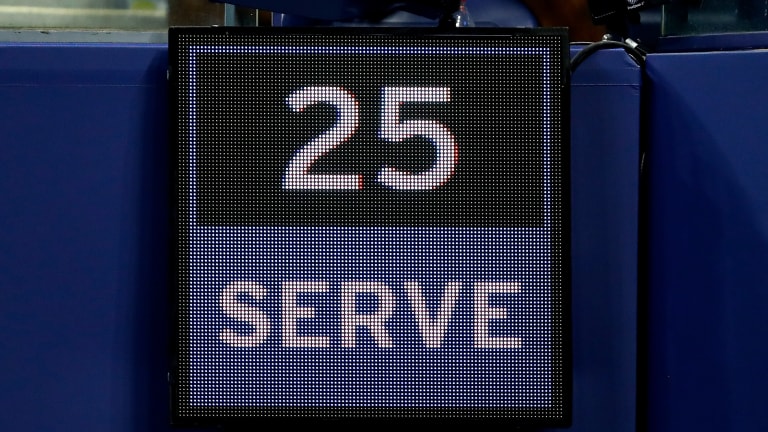
The 10 Biggest Off-Court Stories of 2018
© 2018 Getty Images
Advertising
Following years of complaints that the traditional form of Davis Cup was too time-consuming, complicated and hard to follow for the modern game, men's tennis now has three streamlined, compact team competitions instead: a revamped Davis Cup, a renewed ATP Cup, and the recently started Laver Cup.
But together, they will take up even more weeks in the schedule and create even more confusion when these very similar events are played within weeks of each other.
No wonder there is talk—both humorous and serious—of creating a 'Cup Cup' by combining some or all of these competing competitions.
A highly contentious vote at the ITF's annual general meeting approved sweeping changes to the Davis Cup, turning it into a one-week, 18-nation competition with the compromise of an initial round of home-and-away qualification ties. The decision was driven by the more than $120 million annually offered by the investment group Kosmos, backed by soccer star Gerard Pique, for rights to the historic team competition.
The ATP, undeterred, has announced its own team competition to be played at the beginning of the 2020 season, a little more than five weeks following the first edition of the revamped Davis Cup. It will be played across 10 days and involve 24 nations in three Australian cities, reflecting that Tennis Australia is partnering with the tour to hold the event.
The Laver Cup, which was started in 2017 by the Roger Federer-owned Team8 agency in partnership with Tennis Australia and now the USTA, is a three-day Europe vs. rest-of-the-world competition played two weeks after the US Open. But the ITF has indicated it is interested in moving Davis Cup to the same week as the Laver Cup, which fits better with player schedules. Laver Cup organizers want to keep their spot.
So for now, not much is settled except that players will be getting a lot more to play for their country—the Davis Cup will be offering $20 million in prize money, the ATP Cup $15 million and the Laver Cup millions in appearance fees, along with $1.5 million to the winning team.
This restless state of affairs was neatly captured by the ITF president, Dave Haggerty, getting booed by the crowds during the Davis Cup final between France and Croatia. But there was also a fitting finish to the traditional Davis Cup, as two of its most committed teams played each other in the final and then shared a hug in the locker rooms. The touching gesture captured much of what national team competition has meant to the sport, amid the uncertainly of what it will from now on.
2. Serena in the spotlight
The sport experimented with one of its most significant tweaks in years as a shot clock was introduced for main-draw play at the US Open, along with most of the lead-up events. But while it offered a new visual on court, lenient application meant there was little difference to the pace of play.
There were plenty of other rules changes, intended and unintended, during a wild two weeks of officiating at Flushing Meadows. Along with the mid-event introduction of a men's heat rule, the tournament adjusted its clothing change policy for women following the controversy around Alize Cornet being penalized for briefly removing her top to wear it the right away. Even officials got into the act: Mohamed Layhani climbed down from his chair to offer a pep talk to a tanking Nick Kyrgios, while umpires spoke of a boycott when the USTA president sided with Serena Williams rather than tournament umpire Carlos Ramos.
The Grand Slams introduced a rule that allowed players to receive half their prize money if they withdrew when unfit to play. It created an unexpected flurry of interest in the alternate sign-in process as players rushed to fill vacated spots: the 10-hour drive by Marco Trungelliti to sign in for the French Open being the most extreme.
The ATP NextGen Finals in Milan experimented with getting players to fetch their own towels, along with other changes like video review, but most players did not like the change.
There will be more changes at the majors in 2019, as a fifth-set tiebreak at 12-12 is set to be introduced at Wimbledon, and the Aussie Open is considering a match tiebreak at 6-6 in deciding sets.
Advertising
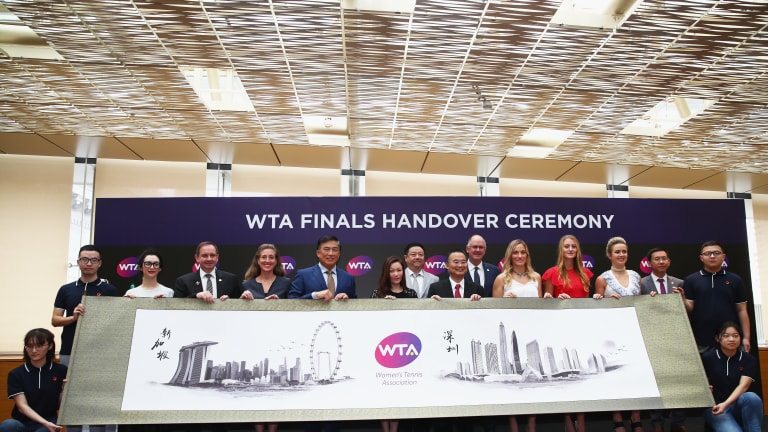
The 10 Biggest Off-Court Stories of 2018
© 2018 Getty Images
Advertising
Reaching two Grand Slam finals since returning to tour from the birth of her first child, Serena Williams' comeback hasn't exactly been shabby. But she had an even bigger impact beyond the court, reflecting a celebrity status that is now independent of the sport.
It began even before she played her first event back. Williams withdrew from the Australian Open and revealed an interview with Vogue magazine that she had experienced significant complications following childbirth, sparking a wider social conversation about African-American maternal health. Williams embraced this position, citing social issues during public statements and appearing in charity campaigns.
While numerous players have recently returned to tour following pregnancy, it was Williams' comeback that prompted criticism of the WTA's ranking protections for such players. They are given a special ranking upon return, but it cannot be used for seeding. Williams was still given a special seeding by Wimbledon, though organizers did not specify why, followed by the US Open's announcement that it would take Williams's pregnancy leave into account in its own seedings.
The WTA has also revised its policy, allowing players returning from pregnancy extra protections, such as having to play seeds in the opening rounds and a longer period to use their special rankings—changes likely to have been most influenced by Williams.
Williams' recognizability was further underlined in being one of the most prominent guests at what was perhaps the biggest society event of the year, the royal wedding between Britain's Prince Harry and American actress Meghan Markle. Williams's daughter, Alexis, became a star in her own right, getting familiar with the tour as she traveled with her mom.
The catsuit Williams wore for the French Open grabbed attention during the event but even more when tournament organizers said they planned to ban it. The story became a hot topic when the comments were published just before the US Open, especially because the suit had been designed to provide compression following Williams's health problems. The furore also heightened notice of the designer 'tutu' dress she wore at Flushing Meadows.
Some big tournament are moving to new places. The revamped Davis Cup will be played in Madrid, the WTA Finals is moving to Shenzhen, and the Miami Open shifts to a downtown location in the stadium used by the NFL's Miami Dolphins.
Lower level events are getting a makeover as the ATP changed Challengers to a Monday-Sunday schedule that includes qualifying, with new points and prize money requirements. The ITF is launching a Transition Tour, which will take the place of the ITF Pro Circuit. It will not offer ATP ranking points—players will instead get ITF points, and higher-ranked players will get a few select spots at ATP Challengers.
There will also be bigger doubles draws at ATP tournaments.
And the tour is also introducing a new look, going from the ATP World Tour back to ATP Tour, with a redesigned logo and marketing campaign. The Australian Open and French Open introduced new-look websites when they were dropped by IBM, but to less than rave reviews.
Advertising

The 10 Biggest Off-Court Stories of 2018
© 2018 Getty Images
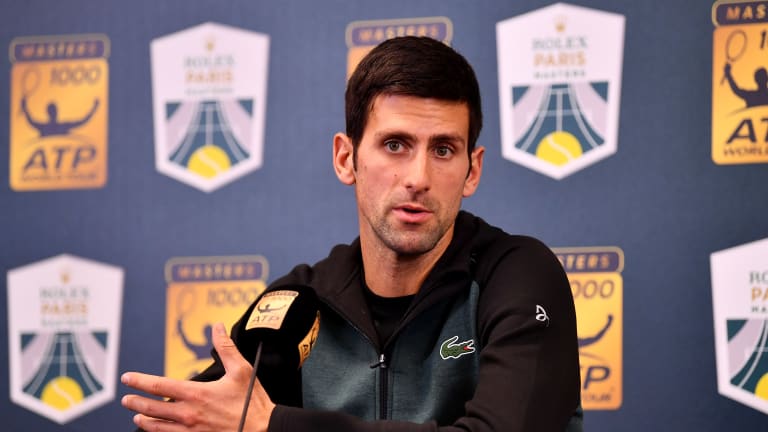
The 10 Biggest Off-Court Stories of 2018
© 2018 Getty Images
Advertising
But controversy also trailed Williams during the season. At Indian Wells, she was asked—by this journalist—about the Therapeutic Use Exemptions (TUEs) she had received to take an otherwise banned substance during the 2015 French Open, which was among several similar exemptions she had received airing that period. Williams said she had been sick during the event, and adamantly insisted she would not cheat as she wanted to be a role model for her daughter. Following a first-round defeat at Miami, Williams walked off court and left the tournament, not giving the required press conference.
A scheduled fourth-round clash with Maria Sharapova at the French Open reignited their simmering feud, this time around Sharapova's claim that Williams had cried following the Russian's victory at Wimbledon, and subsequently used an expletive to describe Sharapova. Williams slammed what she called a second-hand account, and then withdrew from the highly-anticipated meeting with an injury.
Another anti-doping issue came up just before Wimbledon, when WTA CEO Steve Simon was heard in a cell phone conversation saying that Williams had called him to complain about the amount of drug testing she was receiving, including an incident when a tester had come to her home unscheduled and initially refused to leave. Williams confirmed this, including that she had not returned to provide a sample because she was hours away at the time. She called the frequency of testing "discrimination," though anti-doping officials said she was being tested more frequently at her home because she was playing few events and not being tested as frequently during tournaments.
These two currents of celebrity and controversy came together in a wave at the US Open, where Williams was given three code violations during the final and accused the umpire of sexism. Williams was, correctly, given a warning for coaching when her coach, Patrick Mouratoglou, sent her a signal during the second set, and the 23-time Grand Slam champion demanded an apology from umpire Carlos Ramos for what she perceived as an implicit accusation of cheating.
Williams, who may have been under the impression that the warning had been withdrawn, then cracked a racquet, getting a point penalty for the second offence.
"Unbelievable, every time I play here I have problems," she said, likely referring to a spate of poor linecalling in 2004 and angry confrontations with officials during finals in 2009 and 2011. "I did not get coaching, I don't cheat. You need to make an announcement. I have a daughter and I stand for what's right for her."
The next change of sides saw Williams give another long speech to the umpire, during which she called him a "liar" and a "thief" while again demanding an apology for insinuating she was cheating. That got her a game penalty for a third offence, prompting Williams to protest to the tournament referee and supervisor that there were a lot of men "who have said a lot of things" and she had been penalized "because I am a woman, and that’s not right."
The episode, which had unfolded in national prime time and on screens around the world, set off a firestorm of public and media comment that went on for weeks. Both Williams and the umpire were defended and criticized in turn, though broadly speaking, tennis followers tended to side with the umpire, while casual watchers were more inclined to agree with Williams's wider social perspective.
It might have been good or bad, but it was definitely publicity. Williams was mentioned among those considered for Time's Person of the Year, and placed seventh among the most mentioned athletes on Twitter.
The season began with Djokovic speaking to players at the Australian Open about potentially starting a union and going on a Grand Slam strike. It finished with the Djokovic-led ATP Player Council voting one of their three representatives, Roger Rasheed, off the ATP Board because they did not like the prize money agreement he had voted for.
At the moment, players are to get a 4-6 percent increase at ATP tournaments, while talks with the Grand Slams are ongoing. But their ambitions are far bigger.
Advertising

The 10 Biggest Off-Court Stories of 2018
© AFP/Getty Images
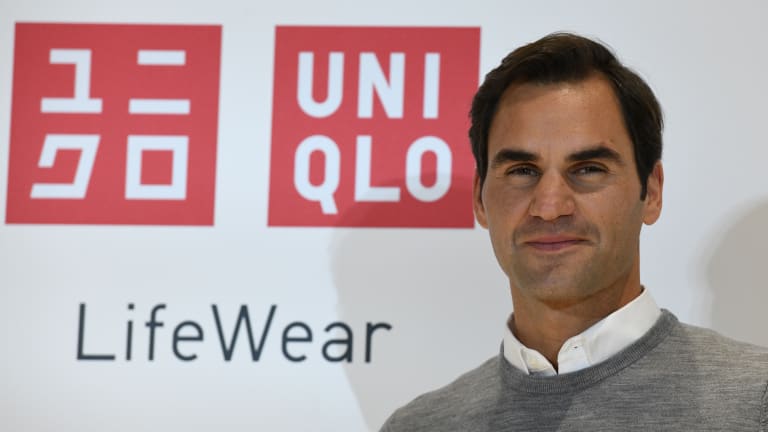
The 10 Biggest Off-Court Stories of 2018
© AFP/Getty Images
Advertising
The intricacy and intrigue of court scheduling usually stays inside the referee's office, but it was flung into the open this season perhaps like never before.
Two days of scorching heat during the first week of the Australian Open meant a huge difference between day and night conditions, accompanied by more scrutiny of who played when. The most ballyhooed was Thursday's decision to schedule Novak Djokovic and Gael Monfils during the day while Roger Federer played Jan-Lennard Struff at night. It was slightly surprising given that Djokovic-Monfils was the more attractive matchup, even though Federer was otherwise a night session regular as the biggest name in the tournament.
But there was a twist. While Federer had said he planned to request a night match, ESPN commentator Chris Fowler revealed that Djokovic's then-coach Andre Agassi had said Djokovic wanted the day session. That seemed puzzling since Djokovic has frequently had problems in the heat during his career, but during a four-set win it became apparent that he was a lot fitter than Monfils.
Djokovic, for his part, said he did not put in a specific request. "No, I think it was just, you know, whatever they put me," he said, but that would likely have been interpreted as having no preference.
Still, players endured 40 C (104 F) that day, with no roof used because the tournament's heat index—which uses temperature and humidity—was still 31.7, below the 32.5 required for the heat policy to come into effect. The following day was even hotter, but with less humidity, so play was again not stopped. Several players, including Djokovic and Monfils, complained that conditions were too hot.
Interestingly, all four men's and women's finalists—Federer, Marin Cilic, Caroline Wozniacki and Simona Halep—played at night during those two sweltering days. But Halep, who had thrilled the crowds but not done herself any favors by playing two marathon three-setters during the tournament, then played another three-setter in the heat and had to be hospitalized following the final.
The roof was shut for the men's final the next day because, as officials noted, it was the first time all tournament that the heat index was above 32.5, even when the final was played in the evening.
The news that Roger Federer was switching from longtime clothing sponsor Nike to Uniqlo made big waves, especially when the unannounced move was confirmed by Federer wearing new apparel as he walked onto Centre Court at Wimbledon.
Part of the interest was the figures involved—a reported $30 million annually, unprecedented in tennis. There were other aspects to the switch, like arranging a new shoe contract while Federer kept wearing Nikes, and the eventual return of the RF logo from Nike.
It perhaps reflects why Federer is the world's top-earning athlete in terms of sponsorship, with around nine corporate partners and an income of $65 million off the court, according to Forbes.
Add to this growing business side the Team8 agency Federer started with his agent, Tony Godsick, which now represents a handful of other tennis players. It also has a large ownership stake in Laver Cup, with Tennis Australia and the USTA as the other investors.
These expanding roles prompted recent criticism from fellow player Julien Benneteau, who said Federer was getting involved in conflicts of interest and getting privileges which were a 'little excessive' from tournaments.
But as Benneteau also noted, "Federer is a legend of the game. There is no one else who can bring 15,000 people to [the Paris Masters at] Bercy."
Advertising
Statement on roof closure. pic.twitter.com/BBwNx6b8Lc
— #AusOpen (@AustralianOpen) January 28, 2018
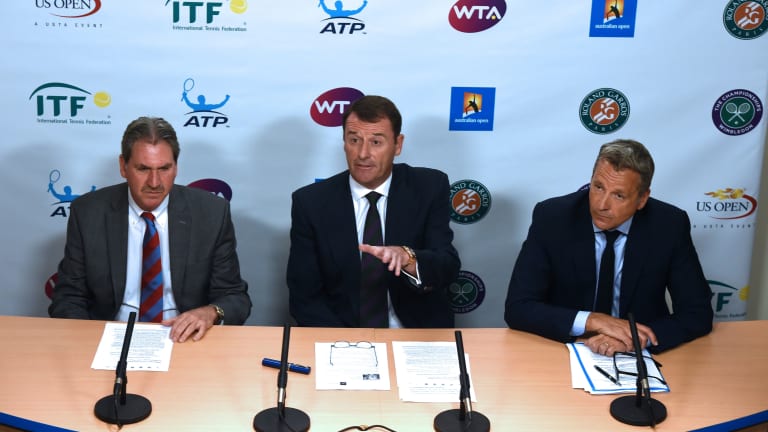
The 10 Biggest Off-Court Stories of 2018
© AFP/Getty Images
Advertising
It was generally perceived that the indoor conditions would favor Federer, and unlike Cilic, he had chosen to warm up indoors even before the announcement from officials that the roof would be shut. Cilic appeared to take a set to get used to the indoor conditions, with Federer winning in five sets. The Croat would complain about the decision to play indoors for the first time all tournament.
But if Federer got some scheduling breaks at Melbourne, he would get no such thing at his next two majors. At Wimbledon, it would be Djokovic making a request to play his quarterfinal on Centre Court, sending Federer to No. 1 Court, on which he had not played in years.
Djokovic's insistence was likely based on the valid concern that he would otherwise have less playing time on Centre Court than his opponents in the final rounds. But it left Federer venturing onto No. 1 Court 1 against a tough quarterfinal opponent in Kevin Anderson, who was also more familiar with the stadium. Though Federer would have match points in the third set, Anderson came back to win in five sets and Federer would subsequently reveal that a hand injury had affected him during the tournament.
At a blisteringly hot US Open, Federer would play his fourth round match in the night session—as usual—but with 82 percent humidity and poor air flow in Arthur Ashe stadium. Federer had problems with the demanding conditions and was quite ill following his four-set defeat, according to ESPN commentator and the wife of Federer's agent, Mary Joe Fernandez. Meanwhile, his little-known opponent John Millman was from notoriously-humid Brisbane, as Federer noted, and coped much better that evening.
The following night, the doors were left open in Ashe to improve airflow in the stadium. Even before, the tournament had introduced a new heat break for the men because of the conditions, though there was also confusion and criticism around the impromptu change.
But rain rather than heat was the problem for much of the hardcourt season. At Cincinnati, Federer had to do double duty, playing his quarterfinal and semifinal on the same day. Heavy rain during Montreal also backed up Halep, who had to come back from a third-round win at night to play a quarterfinal the next day. A furious Halep accused the WTA of unfairness, saying they "always try to put me down in the schedule," though she did eventually win the tournament.
And the schedule got so clogged in Washington, D.C. that Andy Murray finished a match at 3 a.m. and quit the tournament rather than play again the next day, even though further rain meant he would not have had to take the court.
The independent panel investigating tennis' efforts to combat match-fixing published its interim findings, confirming much of what was widely known within the sport.
The review said there had been "very significant" corruption at "lower and middle" events like the ITF Pro Circuit and ATP Challengers, and "some" corruption at the tour level but not in significant contests.
It did not accuse authorities of a cover-up, but said the Tennis Integrity Unit (TIU) had at times dragged its feet in investigating potential offences. Based on some of the records published, Britain's Daily Telegraph also revealed that former Grand Slam champion Yevgeny Kafelnikov's 2003 retirement may have been prompted by investigation into apparent fixing, though in a form not then prohibited by the rules.
Problems still appear to exist. This season, European police arrested more than a dozen people in Belgium suspected of regularly placing bets on fixed matches. Based on TIU figures, there are still several dozen suspicious betting alerts each quarter, though these are not necessarily an indication of match fixing. This season, there was also a rare instance of an investigation at the Grand Slam level, involving one men's doubles match at Wimbledon.
There has been increased funding of the TIU since the controversy that led to the review, and an apparent increase in suspensions announced. While most involve low-ranked pros, this season there have also been some tour-level players, like Daniele Bracciali and Potito Starace, who were implicated in fixing by Italian police as far back as 2015.
Advertising

The 10 Biggest Off-Court Stories of 2018
© AFP/Getty Images
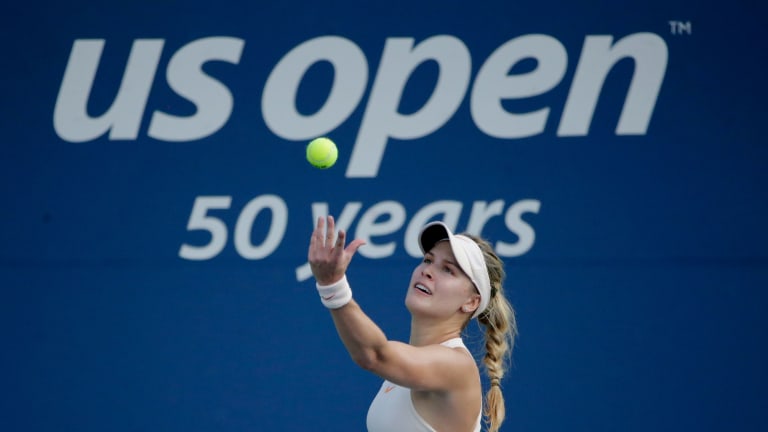
The 10 Biggest Off-Court Stories of 2018
© AFP/Getty Images
Advertising
Back at Wimbledon, there was the season's other big roof controversy—the decision to play the Rafael Nadal-Djokovic semifinal indoors. The match started under the roof because the light was fading by the time the six-hour semifinal before it had finished. The tournament's unusual 11 p.m. curfew meant the match was then stopped in the fourth set, and resumed under the roof the next day despite bright sunlight.
If both players had agreed, the roof could have been opened for the second day of play. Nadal wanted it open, in what would have been better conditions for him. But Djokovic, who benefited from playing indoors, did not. Djokovic won in a tight fifth set. Though it was logical for the Serb to choose his preference, he seemed reluctant to acknowledge it.
"They told us we had to play under the roof," he said, but then added, "I was for the roof because we started to play, and I wanted to play in the same conditions."
Tournament officials told the New York Times that the decision had been based not on a rule but a protocol, which would be re-examined.
But it wasn't surprising Nadal didn't want to play under the roof, as few benefited as much from the elements. The Spaniard was down a break in the third set against Alexander Zverev in the final of Rome before there was a rain delay, coming back to win four straight games. At the French Open, he was down a set and a break to Diego Schwartzman before rain stopped play, and came back looking like a different player to win in four sets.
Eugenie Bouchard's lawsuit against the USTA for a locker room fall in 2015 went to trial, with a jury finding the USTA liable before the parties settled for a rumored several million dollars. That would have come in handy for Bouchard, whose sponsorship income has dried up, and has earned little this season while falling to No. 82 in the rankings.
Another WTA player, Madison Brengle, sued the ITF and WTA for injuries from anti-doping blood testing, saying they did not take into account a condition that produces a severe physical reaction when blood was drawn from her veins.
And a little-publicized set of lawsuits by Madrid owner Ion Tiriac against the WTA was ordered into arbitration. A miffed Tiriac is suing the WTA for its statements involving Ilie Nastase's involvement in a Madrid trophy presentation while he was suspended from the tour, and also alleging that WTA practices are affecting the profitability of his tournament.
Advertising

The 10 Biggest Off-Court Stories of 2018
© 2018 Getty Images
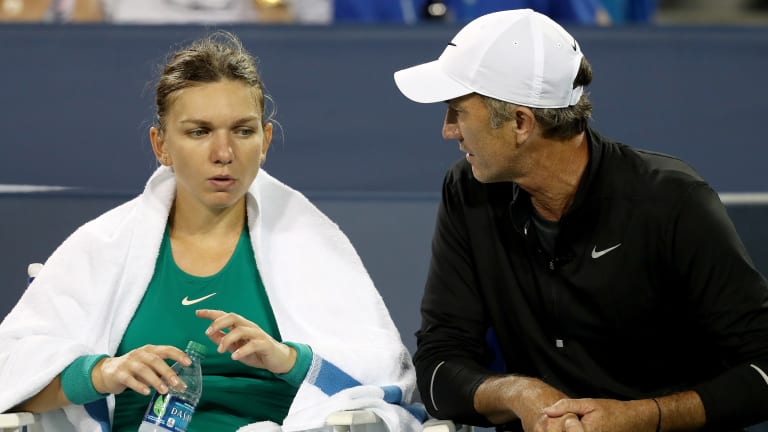
The 10 Biggest Off-Court Stories of 2018
© 2018 Getty Images
Advertising
The sport experimented with one of its most significant tweaks in years as a shot clock was introduced for main-draw play at the US Open, along with most of the lead-up events. But while it offered a new visual on court, lenient application meant there was little difference to the pace of play.
There were plenty of other rules changes, intended and unintended, during a wild two weeks of officiating at Flushing Meadows. Along with the mid-event introduction of a men's heat rule, the tournament adjusted its clothing change policy for women following the controversy around Alize Cornet being penalized for briefly removing her top to wear it the right away. Even officials got into the act: Mohamed Layhani climbed down from his chair to offer a pep talk to a tanking Nick Kyrgios, while umpires spoke of a boycott when the USTA president sided with Serena Williams rather than tournament umpire Carlos Ramos.
The Grand Slams introduced a rule that allowed players to receive half their prize money if they withdrew when unfit to play. It created an unexpected flurry of interest in the alternate sign-in process as players rushed to fill vacated spots: the 10-hour drive by Marco Trungelliti to sign in for the French Open being the most extreme.
The ATP NextGen Finals in Milan experimented with getting players to fetch their own towels, along with other changes like video review, but most players did not like the change.
There will be more changes at the majors in 2019, as a fifth-set tiebreak at 12-12 is set to be introduced at Wimbledon, and the Aussie Open is considering a match tiebreak at 6-6 in deciding sets.
Changing coaches in tennis is nothing new, but this season had an unusually large number of notable players switching up their teams.
Simona Halep: split with Darren Cahill
Angelique Kerber: started with Wim Fissette, then split and brought on Rainer Schuttler
Elina Svitolina: split with Thierry Ascione, trialed Nick Saviano and then named hitting partner Andrew Bettles as coach
Naomi Osaka: started season with Sascha Bajin
Karolina Pliskova: split with Tomas Krupa then brought on Conchita Martinez and Rennae Stubbs
Elise Mertens: split with Robbe Ceyssens, now with David Taylor
Madison Keys: brought on then split with David Taylor
Garbine Muguruza: trialed Conchita Martinez but stayed with Sam Sumyk
Jelena Ostapenko: brought on and split with David Taylor
Venus Williams: split with David Witt
Maria Sharapova: split with Sven Groeneveld and brought on Thomas Hogstedt
Johanna Konta: split with Michael Joyce and brought on Dmitri Zavialoff
Belina Bencic: brought back on her father, Ivan
Victoria Azarenka: switched coaches, then brought on Wim Fissette
Sam Stosur: brought on Nick Watkins
Novak Djokovic: split with Andre Agassi and Radek Stepanek, brought back on Marian Vajda
Rafael Nadal: Carlos Moya becomes chief coach
Alexander Zverev: splits with Juan Carlos Ferrero, brought on Ivan Lendl
Stan Wawrinka: brought back on Magnus Norman
Dominic Thiem: brought on then split with Galo Blanco but stayed with Gunther Bresnik
Borna Coric: brought on Riccardo Piatti
Nikoloz Basilashvili: brought on Jan de Witt
Grigor Dimitrov: brought on Andre Agassi in addition to Dani Vallverdu
Kyle Edmund: brought on Fredrik Rosengren with Mark Hilton
Milos Raonic: brought on Goran Ivanisevic
Gael Monfils: split with Mikael Tillstrom
Lucas Pouille: brought on Amelie Mauresmo
Jo-Wilfried Tsonga: stayed with Thierry Ascione and brought on Sergi Bruguera
The coaching carousel has been in spin.
In 2019, the ATP, WTA—and so much more—are on Tennis Channel Plus:
Advertising

The 10 Biggest Off-Court Stories of 2018
© 2018 Getty Images
Advertising
Some big tournament are moving to new places. The revamped Davis Cup will be played in Madrid, the WTA Finals is moving to Shenzhen, and the Miami Open shifts to a downtown location in the stadium used by the NFL's Miami Dolphins.
Lower level events are getting a makeover as the ATP changed Challengers to a Monday-Sunday schedule that includes qualifying, with new points and prize money requirements. The ITF is launching a Transition Tour, which will take the place of the ITF Pro Circuit. It will not offer ATP ranking points—players will instead get ITF points, and higher-ranked players will get a few select spots at ATP Challengers.
There will also be bigger doubles draws at ATP tournaments.
And the tour is also introducing a new look, going from the ATP World Tour back to ATP Tour, with a redesigned logo and marketing campaign. The Australian Open and French Open introduced new-look websites when they were dropped by IBM, but to less than rave reviews.

The 10 Biggest Off-Court Stories of 2018
© 2018 Getty Images
Advertising
The season began with Djokovic speaking to players at the Australian Open about potentially starting a union and going on a Grand Slam strike. It finished with the Djokovic-led ATP Player Council voting one of their three representatives, Roger Rasheed, off the ATP Board because they did not like the prize money agreement he had voted for.
At the moment, players are to get a 4-6 percent increase at ATP tournaments, while talks with the Grand Slams are ongoing. But their ambitions are far bigger.

The 10 Biggest Off-Court Stories of 2018
© AFP/Getty Images
Advertising
The news that Roger Federer was switching from longtime clothing sponsor Nike to Uniqlo made big waves, especially when the unannounced move was confirmed by Federer wearing new apparel as he walked onto Centre Court at Wimbledon.
Part of the interest was the figures involved—a reported $30 million annually, unprecedented in tennis. There were other aspects to the switch, like arranging a new shoe contract while Federer kept wearing Nikes, and the eventual return of the RF logo from Nike.
It perhaps reflects why Federer is the world's top-earning athlete in terms of sponsorship, with around nine corporate partners and an income of $65 million off the court, according to Forbes.
Add to this growing business side the Team8 agency Federer started with his agent, Tony Godsick, which now represents a handful of other tennis players. It also has a large ownership stake in Laver Cup, with Tennis Australia and the USTA as the other investors.
These expanding roles prompted recent criticism from fellow player Julien Benneteau, who said Federer was getting involved in conflicts of interest and getting privileges which were a 'little excessive' from tournaments.
But as Benneteau also noted, "Federer is a legend of the game. There is no one else who can bring 15,000 people to [the Paris Masters at] Bercy."

The 10 Biggest Off-Court Stories of 2018
© AFP/Getty Images
Advertising
The independent panel investigating tennis' efforts to combat match-fixing published its interim findings, confirming much of what was widely known within the sport.
The review said there had been "very significant" corruption at "lower and middle" events like the ITF Pro Circuit and ATP Challengers, and "some" corruption at the tour level but not in significant contests.
It did not accuse authorities of a cover-up, but said the Tennis Integrity Unit (TIU) had at times dragged its feet in investigating potential offences. Based on some of the records published, Britain's Daily Telegraph also revealed that former Grand Slam champion Yevgeny Kafelnikov's 2003 retirement may have been prompted by investigation into apparent fixing, though in a form not then prohibited by the rules.
Problems still appear to exist. This season, European police arrested more than a dozen people in Belgium suspected of regularly placing bets on fixed matches. Based on TIU figures, there are still several dozen suspicious betting alerts each quarter, though these are not necessarily an indication of match fixing. This season, there was also a rare instance of an investigation at the Grand Slam level, involving one men's doubles match at Wimbledon.
There has been increased funding of the TIU since the controversy that led to the review, and an apparent increase in suspensions announced. While most involve low-ranked pros, this season there have also been some tour-level players, like Daniele Bracciali and Potito Starace, who were implicated in fixing by Italian police as far back as 2015.

The 10 Biggest Off-Court Stories of 2018
© AFP/Getty Images
Advertising
Eugenie Bouchard's lawsuit against the USTA for a locker room fall in 2015 went to trial, with a jury finding the USTA liable before the parties settled for a rumored several million dollars. That would have come in handy for Bouchard, whose sponsorship income has dried up, and has earned little this season while falling to No. 82 in the rankings.
Another WTA player, Madison Brengle, sued the ITF and WTA for injuries from anti-doping blood testing, saying they did not take into account a condition that produces a severe physical reaction when blood was drawn from her veins.
And a little-publicized set of lawsuits by Madrid owner Ion Tiriac against the WTA was ordered into arbitration. A miffed Tiriac is suing the WTA for its statements involving Ilie Nastase's involvement in a Madrid trophy presentation while he was suspended from the tour, and also alleging that WTA practices are affecting the profitability of his tournament.

The 10 Biggest Off-Court Stories of 2018
© 2018 Getty Images
Advertising
Changing coaches in tennis is nothing new, but this season had an unusually large number of notable players switching up their teams.
Simona Halep: split with Darren Cahill
Angelique Kerber: started with Wim Fissette, then split and brought on Rainer Schuttler
Elina Svitolina: split with Thierry Ascione, trialed Nick Saviano and then named hitting partner Andrew Bettles as coach
Naomi Osaka: started season with Sascha Bajin
Karolina Pliskova: split with Tomas Krupa then brought on Conchita Martinez and Rennae Stubbs
Elise Mertens: split with Robbe Ceyssens, now with David Taylor
Madison Keys: brought on then split with David Taylor
Garbine Muguruza: trialed Conchita Martinez but stayed with Sam Sumyk
Jelena Ostapenko: brought on and split with David Taylor
Venus Williams: split with David Witt
Maria Sharapova: split with Sven Groeneveld and brought on Thomas Hogstedt
Johanna Konta: split with Michael Joyce and brought on Dmitri Zavialoff
Belina Bencic: brought back on her father, Ivan
Victoria Azarenka: switched coaches, then brought on Wim Fissette
Sam Stosur: brought on Nick Watkins
Novak Djokovic: split with Andre Agassi and Radek Stepanek, brought back on Marian Vajda
Rafael Nadal: Carlos Moya becomes chief coach
Alexander Zverev: splits with Juan Carlos Ferrero, brought on Ivan Lendl
Stan Wawrinka: brought back on Magnus Norman
Dominic Thiem: brought on then split with Galo Blanco but stayed with Gunther Bresnik
Borna Coric: brought on Riccardo Piatti
Nikoloz Basilashvili: brought on Jan de Witt
Grigor Dimitrov: brought on Andre Agassi in addition to Dani Vallverdu
Kyle Edmund: brought on Fredrik Rosengren with Mark Hilton
Milos Raonic: brought on Goran Ivanisevic
Gael Monfils: split with Mikael Tillstrom
Lucas Pouille: brought on Amelie Mauresmo
Jo-Wilfried Tsonga: stayed with Thierry Ascione and brought on Sergi Bruguera
The coaching carousel has been in spin.
In 2019, the ATP, WTA—and so much more—are on Tennis Channel Plus: